Royal Bank of Scotland: PESTEL Analysis and Business Report
VerifiedAdded on 2022/12/26
|11
|3297
|90
Report
AI Summary
This report provides a comprehensive business analysis of the Royal Bank of Scotland (RBS). It begins with an introduction to business analysis, defining its importance in assessing internal and external environments to enhance efficiency and reduce risks. The report then examines the history and organizational structure of RBS, including its governance by the Scottish government and regulatory bodies, along with the roles of key directors and management teams. The second task evaluates the significance of PESTEL analysis for organizations, highlighting its role in identifying strengths, weaknesses, opportunities, and threats, as well as aiding in strategic planning and risk reduction. The third task applies the PESTEL framework to analyze RBS's external environment, considering political factors (such as risk of invasion, corruption, and taxation), environmental factors (like climate change and waste management), social factors, technological factors, economic factors, and legal factors that affect the bank's operations. The report concludes by summarizing the key findings and insights gained from the analysis.
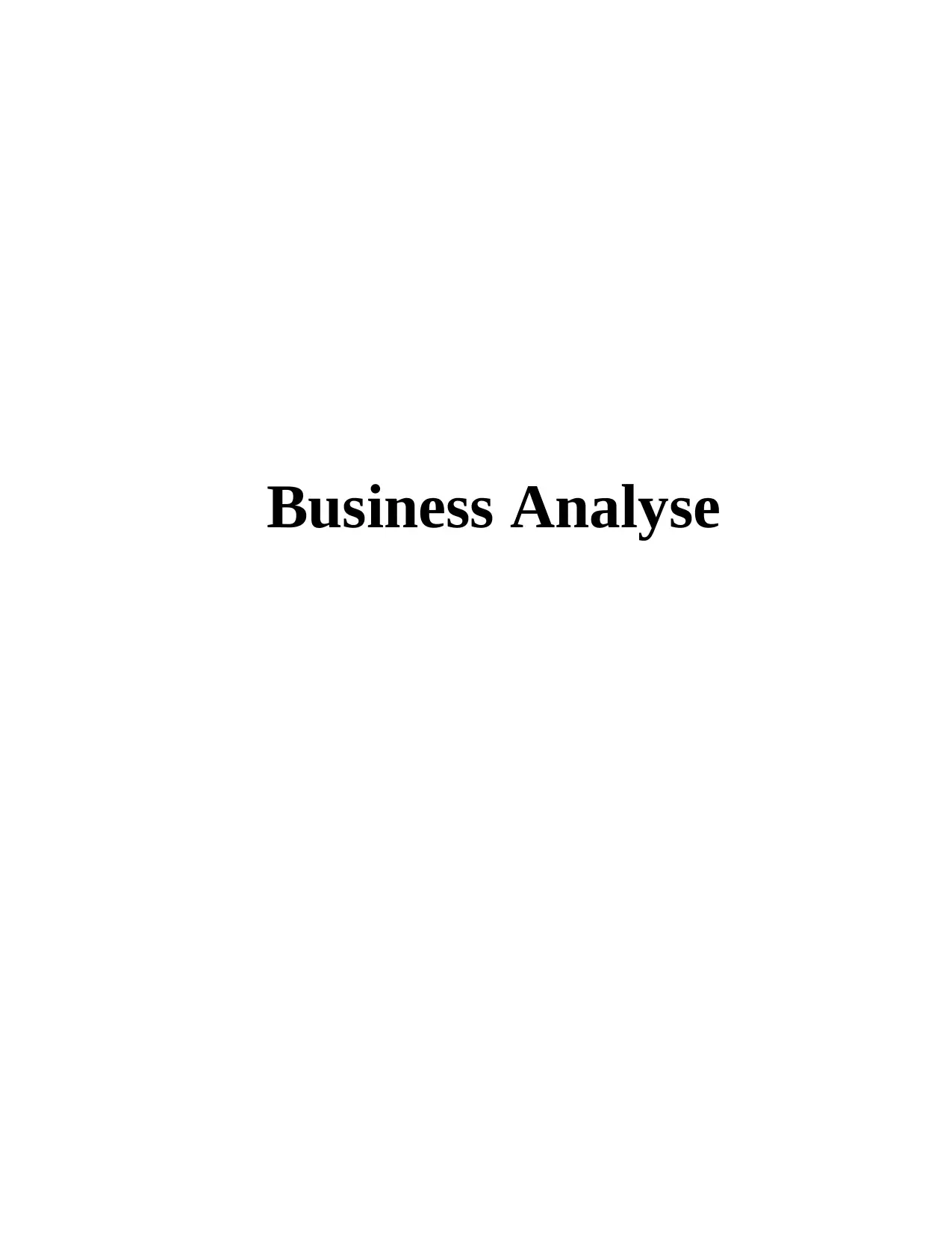
Business Analyse
Paraphrase This Document
Need a fresh take? Get an instant paraphrase of this document with our AI Paraphraser
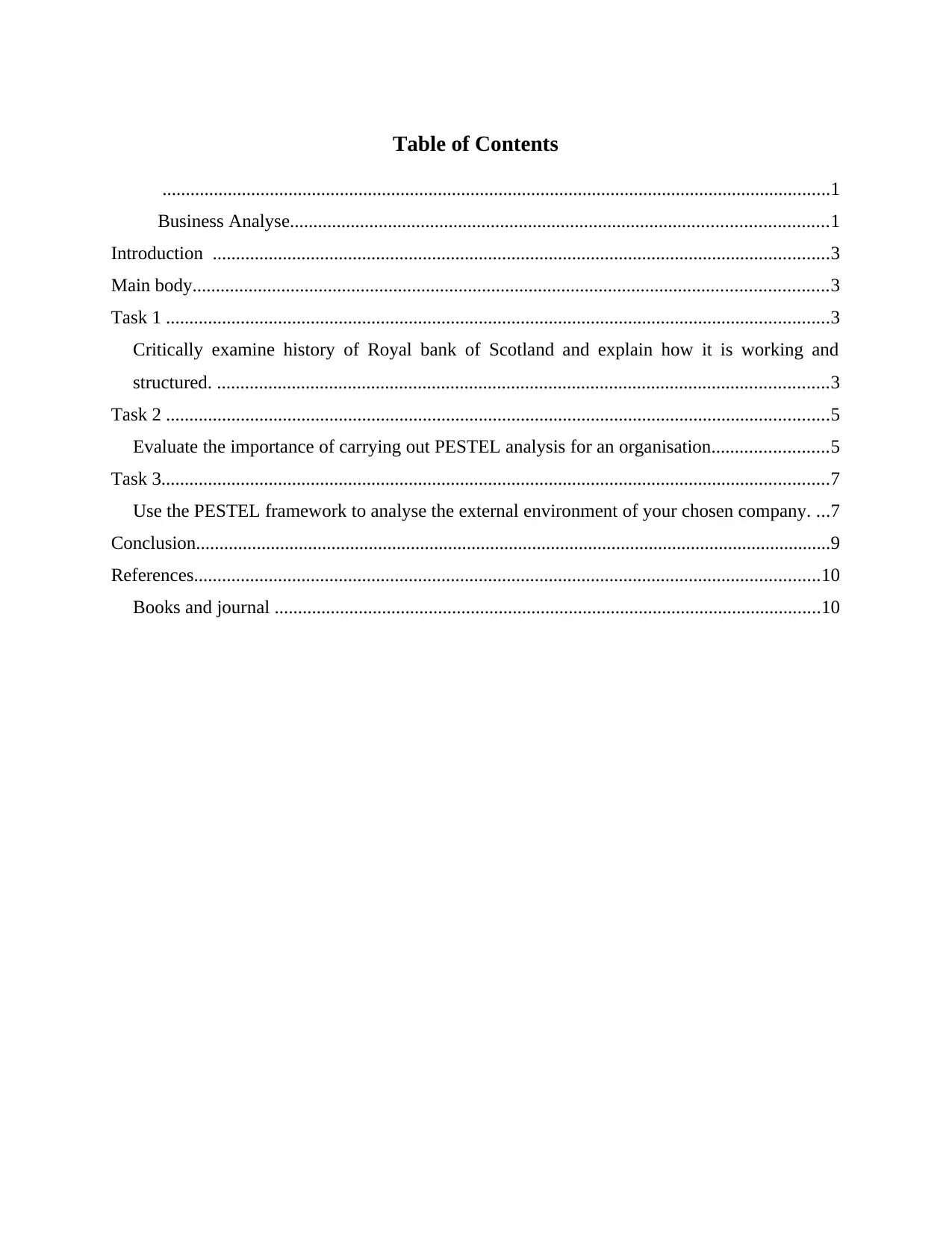
Table of Contents
...............................................................................................................................................1
Business Analyse...................................................................................................................1
Introduction ....................................................................................................................................3
Main body........................................................................................................................................3
Task 1 ..............................................................................................................................................3
Critically examine history of Royal bank of Scotland and explain how it is working and
structured. ...................................................................................................................................3
Task 2 ..............................................................................................................................................5
Evaluate the importance of carrying out PESTEL analysis for an organisation.........................5
Task 3...............................................................................................................................................7
Use the PESTEL framework to analyse the external environment of your chosen company. ...7
Conclusion........................................................................................................................................9
References......................................................................................................................................10
Books and journal .....................................................................................................................10
...............................................................................................................................................1
Business Analyse...................................................................................................................1
Introduction ....................................................................................................................................3
Main body........................................................................................................................................3
Task 1 ..............................................................................................................................................3
Critically examine history of Royal bank of Scotland and explain how it is working and
structured. ...................................................................................................................................3
Task 2 ..............................................................................................................................................5
Evaluate the importance of carrying out PESTEL analysis for an organisation.........................5
Task 3...............................................................................................................................................7
Use the PESTEL framework to analyse the external environment of your chosen company. ...7
Conclusion........................................................................................................................................9
References......................................................................................................................................10
Books and journal .....................................................................................................................10
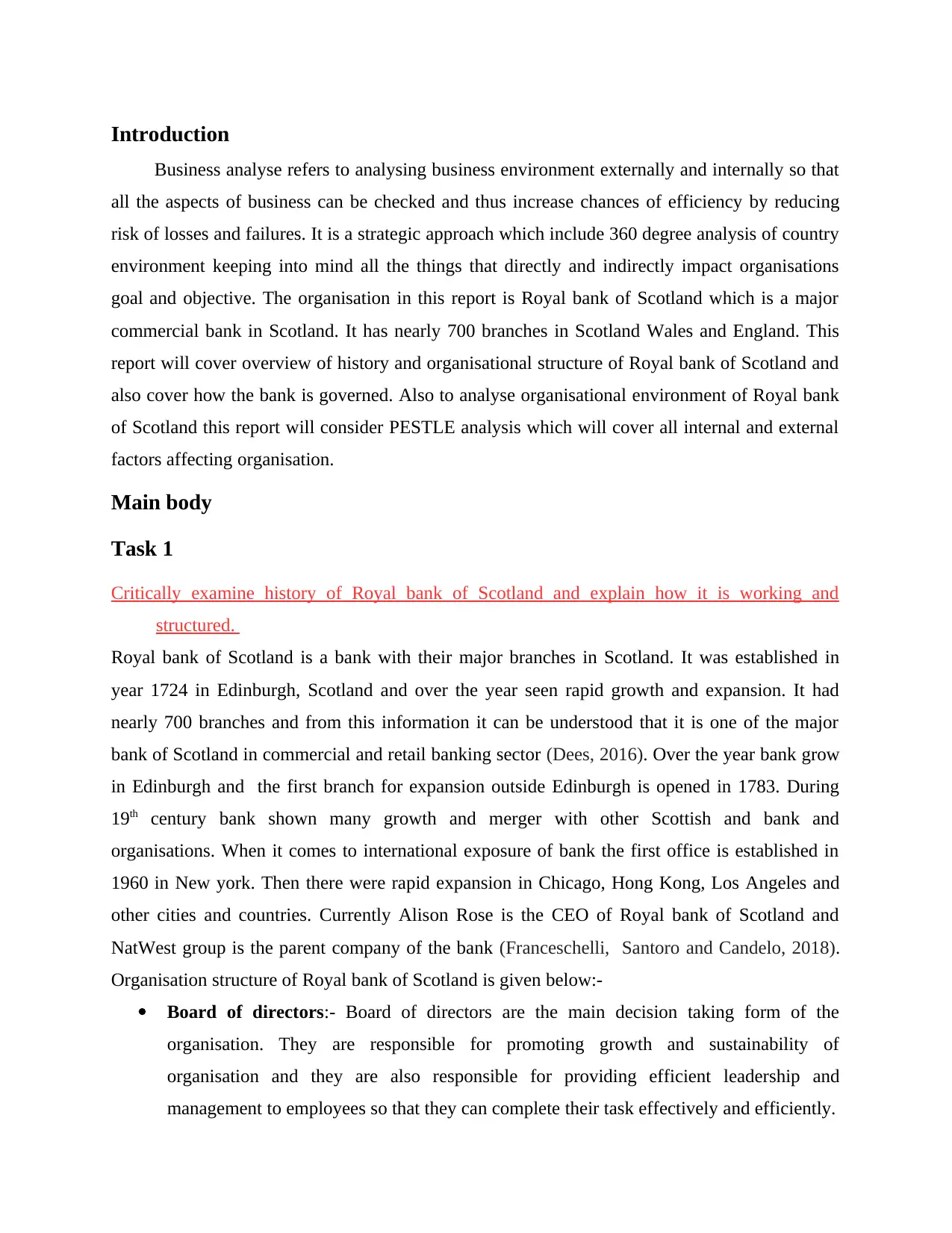
Introduction
Business analyse refers to analysing business environment externally and internally so that
all the aspects of business can be checked and thus increase chances of efficiency by reducing
risk of losses and failures. It is a strategic approach which include 360 degree analysis of country
environment keeping into mind all the things that directly and indirectly impact organisations
goal and objective. The organisation in this report is Royal bank of Scotland which is a major
commercial bank in Scotland. It has nearly 700 branches in Scotland Wales and England. This
report will cover overview of history and organisational structure of Royal bank of Scotland and
also cover how the bank is governed. Also to analyse organisational environment of Royal bank
of Scotland this report will consider PESTLE analysis which will cover all internal and external
factors affecting organisation.
Main body
Task 1
Critically examine history of Royal bank of Scotland and explain how it is working and
structured.
Royal bank of Scotland is a bank with their major branches in Scotland. It was established in
year 1724 in Edinburgh, Scotland and over the year seen rapid growth and expansion. It had
nearly 700 branches and from this information it can be understood that it is one of the major
bank of Scotland in commercial and retail banking sector (Dees, 2016). Over the year bank grow
in Edinburgh and the first branch for expansion outside Edinburgh is opened in 1783. During
19th century bank shown many growth and merger with other Scottish and bank and
organisations. When it comes to international exposure of bank the first office is established in
1960 in New york. Then there were rapid expansion in Chicago, Hong Kong, Los Angeles and
other cities and countries. Currently Alison Rose is the CEO of Royal bank of Scotland and
NatWest group is the parent company of the bank (Franceschelli, Santoro and Candelo, 2018).
Organisation structure of Royal bank of Scotland is given below:-
Board of directors:- Board of directors are the main decision taking form of the
organisation. They are responsible for promoting growth and sustainability of
organisation and they are also responsible for providing efficient leadership and
management to employees so that they can complete their task effectively and efficiently.
Business analyse refers to analysing business environment externally and internally so that
all the aspects of business can be checked and thus increase chances of efficiency by reducing
risk of losses and failures. It is a strategic approach which include 360 degree analysis of country
environment keeping into mind all the things that directly and indirectly impact organisations
goal and objective. The organisation in this report is Royal bank of Scotland which is a major
commercial bank in Scotland. It has nearly 700 branches in Scotland Wales and England. This
report will cover overview of history and organisational structure of Royal bank of Scotland and
also cover how the bank is governed. Also to analyse organisational environment of Royal bank
of Scotland this report will consider PESTLE analysis which will cover all internal and external
factors affecting organisation.
Main body
Task 1
Critically examine history of Royal bank of Scotland and explain how it is working and
structured.
Royal bank of Scotland is a bank with their major branches in Scotland. It was established in
year 1724 in Edinburgh, Scotland and over the year seen rapid growth and expansion. It had
nearly 700 branches and from this information it can be understood that it is one of the major
bank of Scotland in commercial and retail banking sector (Dees, 2016). Over the year bank grow
in Edinburgh and the first branch for expansion outside Edinburgh is opened in 1783. During
19th century bank shown many growth and merger with other Scottish and bank and
organisations. When it comes to international exposure of bank the first office is established in
1960 in New york. Then there were rapid expansion in Chicago, Hong Kong, Los Angeles and
other cities and countries. Currently Alison Rose is the CEO of Royal bank of Scotland and
NatWest group is the parent company of the bank (Franceschelli, Santoro and Candelo, 2018).
Organisation structure of Royal bank of Scotland is given below:-
Board of directors:- Board of directors are the main decision taking form of the
organisation. They are responsible for promoting growth and sustainability of
organisation and they are also responsible for providing efficient leadership and
management to employees so that they can complete their task effectively and efficiently.
⊘ This is a preview!⊘
Do you want full access?
Subscribe today to unlock all pages.

Trusted by 1+ million students worldwide
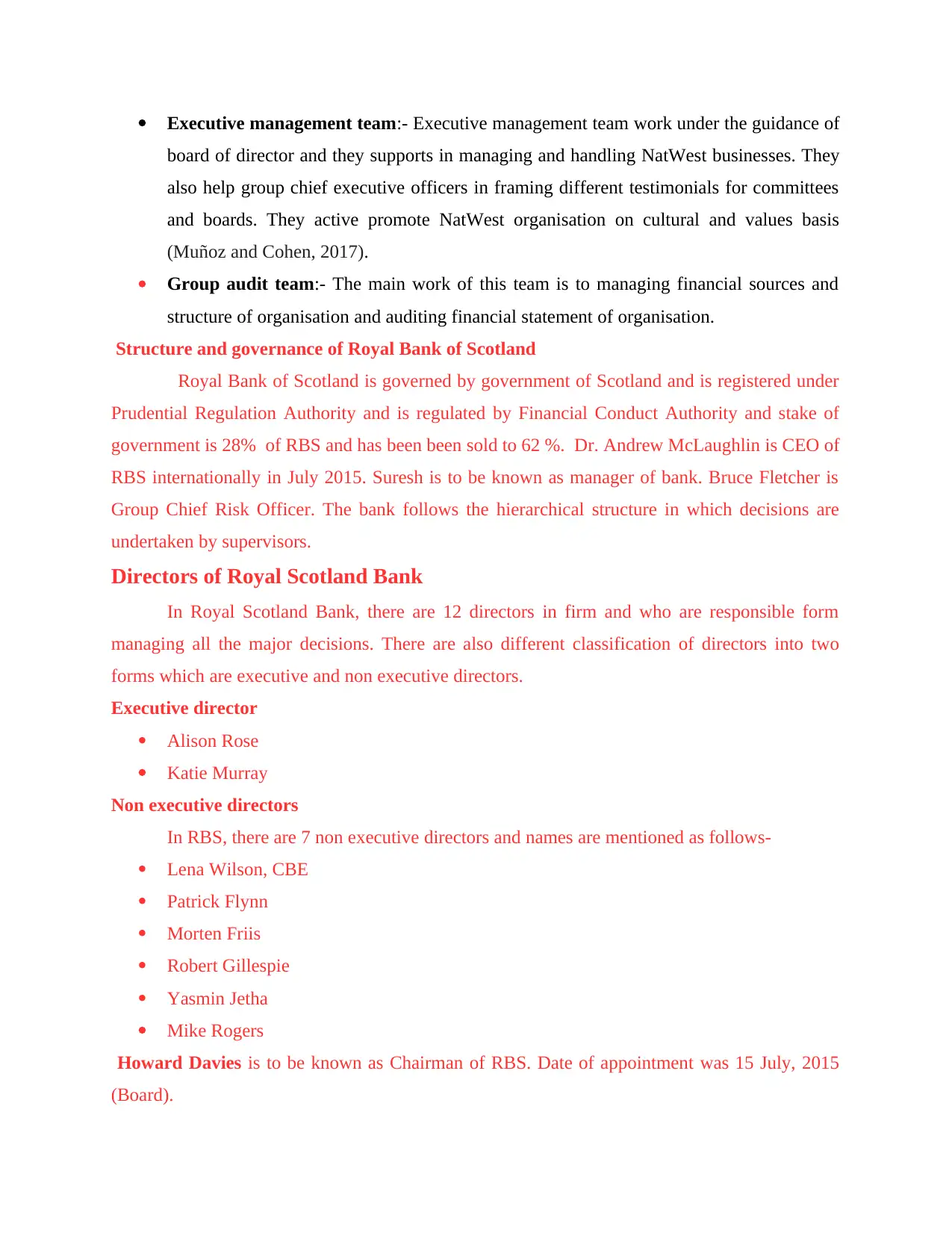
Executive management team:- Executive management team work under the guidance of
board of director and they supports in managing and handling NatWest businesses. They
also help group chief executive officers in framing different testimonials for committees
and boards. They active promote NatWest organisation on cultural and values basis
(Muñoz and Cohen, 2017).
Group audit team:- The main work of this team is to managing financial sources and
structure of organisation and auditing financial statement of organisation.
Structure and governance of Royal Bank of Scotland
Royal Bank of Scotland is governed by government of Scotland and is registered under
Prudential Regulation Authority and is regulated by Financial Conduct Authority and stake of
government is 28% of RBS and has been been sold to 62 %. Dr. Andrew McLaughlin is CEO of
RBS internationally in July 2015. Suresh is to be known as manager of bank. Bruce Fletcher is
Group Chief Risk Officer. The bank follows the hierarchical structure in which decisions are
undertaken by supervisors.
Directors of Royal Scotland Bank
In Royal Scotland Bank, there are 12 directors in firm and who are responsible form
managing all the major decisions. There are also different classification of directors into two
forms which are executive and non executive directors.
Executive director
Alison Rose
Katie Murray
Non executive directors
In RBS, there are 7 non executive directors and names are mentioned as follows-
Lena Wilson, CBE
Patrick Flynn
Morten Friis
Robert Gillespie
Yasmin Jetha
Mike Rogers
Howard Davies is to be known as Chairman of RBS. Date of appointment was 15 July, 2015
(Board).
board of director and they supports in managing and handling NatWest businesses. They
also help group chief executive officers in framing different testimonials for committees
and boards. They active promote NatWest organisation on cultural and values basis
(Muñoz and Cohen, 2017).
Group audit team:- The main work of this team is to managing financial sources and
structure of organisation and auditing financial statement of organisation.
Structure and governance of Royal Bank of Scotland
Royal Bank of Scotland is governed by government of Scotland and is registered under
Prudential Regulation Authority and is regulated by Financial Conduct Authority and stake of
government is 28% of RBS and has been been sold to 62 %. Dr. Andrew McLaughlin is CEO of
RBS internationally in July 2015. Suresh is to be known as manager of bank. Bruce Fletcher is
Group Chief Risk Officer. The bank follows the hierarchical structure in which decisions are
undertaken by supervisors.
Directors of Royal Scotland Bank
In Royal Scotland Bank, there are 12 directors in firm and who are responsible form
managing all the major decisions. There are also different classification of directors into two
forms which are executive and non executive directors.
Executive director
Alison Rose
Katie Murray
Non executive directors
In RBS, there are 7 non executive directors and names are mentioned as follows-
Lena Wilson, CBE
Patrick Flynn
Morten Friis
Robert Gillespie
Yasmin Jetha
Mike Rogers
Howard Davies is to be known as Chairman of RBS. Date of appointment was 15 July, 2015
(Board).
Paraphrase This Document
Need a fresh take? Get an instant paraphrase of this document with our AI Paraphraser
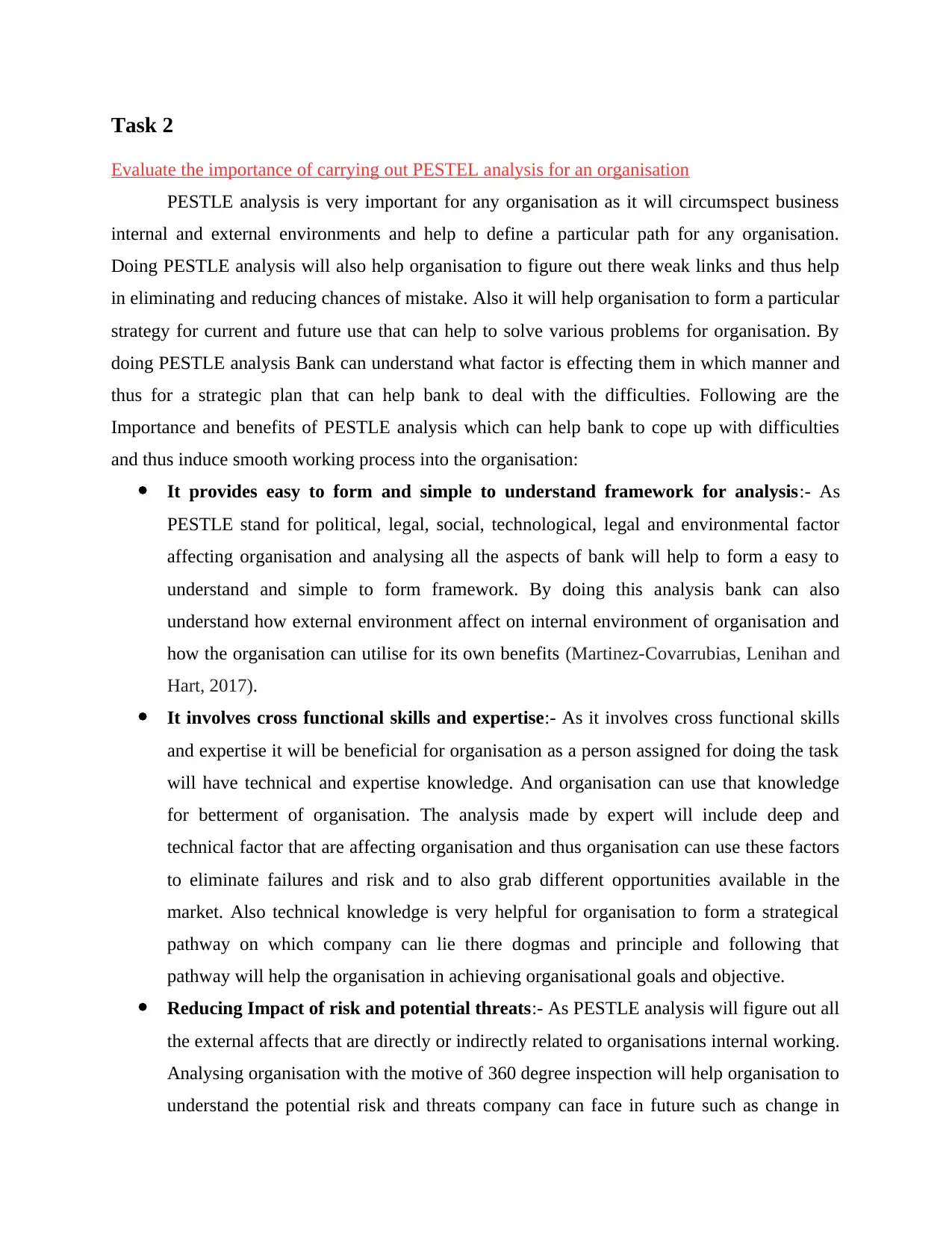
Task 2
Evaluate the importance of carrying out PESTEL analysis for an organisation
PESTLE analysis is very important for any organisation as it will circumspect business
internal and external environments and help to define a particular path for any organisation.
Doing PESTLE analysis will also help organisation to figure out there weak links and thus help
in eliminating and reducing chances of mistake. Also it will help organisation to form a particular
strategy for current and future use that can help to solve various problems for organisation. By
doing PESTLE analysis Bank can understand what factor is effecting them in which manner and
thus for a strategic plan that can help bank to deal with the difficulties. Following are the
Importance and benefits of PESTLE analysis which can help bank to cope up with difficulties
and thus induce smooth working process into the organisation:
It provides easy to form and simple to understand framework for analysis:- As
PESTLE stand for political, legal, social, technological, legal and environmental factor
affecting organisation and analysing all the aspects of bank will help to form a easy to
understand and simple to form framework. By doing this analysis bank can also
understand how external environment affect on internal environment of organisation and
how the organisation can utilise for its own benefits (Martinez-Covarrubias, Lenihan and
Hart, 2017).
It involves cross functional skills and expertise:- As it involves cross functional skills
and expertise it will be beneficial for organisation as a person assigned for doing the task
will have technical and expertise knowledge. And organisation can use that knowledge
for betterment of organisation. The analysis made by expert will include deep and
technical factor that are affecting organisation and thus organisation can use these factors
to eliminate failures and risk and to also grab different opportunities available in the
market. Also technical knowledge is very helpful for organisation to form a strategical
pathway on which company can lie there dogmas and principle and following that
pathway will help the organisation in achieving organisational goals and objective.
Reducing Impact of risk and potential threats:- As PESTLE analysis will figure out all
the external affects that are directly or indirectly related to organisations internal working.
Analysing organisation with the motive of 360 degree inspection will help organisation to
understand the potential risk and threats company can face in future such as change in
Evaluate the importance of carrying out PESTEL analysis for an organisation
PESTLE analysis is very important for any organisation as it will circumspect business
internal and external environments and help to define a particular path for any organisation.
Doing PESTLE analysis will also help organisation to figure out there weak links and thus help
in eliminating and reducing chances of mistake. Also it will help organisation to form a particular
strategy for current and future use that can help to solve various problems for organisation. By
doing PESTLE analysis Bank can understand what factor is effecting them in which manner and
thus for a strategic plan that can help bank to deal with the difficulties. Following are the
Importance and benefits of PESTLE analysis which can help bank to cope up with difficulties
and thus induce smooth working process into the organisation:
It provides easy to form and simple to understand framework for analysis:- As
PESTLE stand for political, legal, social, technological, legal and environmental factor
affecting organisation and analysing all the aspects of bank will help to form a easy to
understand and simple to form framework. By doing this analysis bank can also
understand how external environment affect on internal environment of organisation and
how the organisation can utilise for its own benefits (Martinez-Covarrubias, Lenihan and
Hart, 2017).
It involves cross functional skills and expertise:- As it involves cross functional skills
and expertise it will be beneficial for organisation as a person assigned for doing the task
will have technical and expertise knowledge. And organisation can use that knowledge
for betterment of organisation. The analysis made by expert will include deep and
technical factor that are affecting organisation and thus organisation can use these factors
to eliminate failures and risk and to also grab different opportunities available in the
market. Also technical knowledge is very helpful for organisation to form a strategical
pathway on which company can lie there dogmas and principle and following that
pathway will help the organisation in achieving organisational goals and objective.
Reducing Impact of risk and potential threats:- As PESTLE analysis will figure out all
the external affects that are directly or indirectly related to organisations internal working.
Analysing organisation with the motive of 360 degree inspection will help organisation to
understand the potential risk and threats company can face in future such as change in
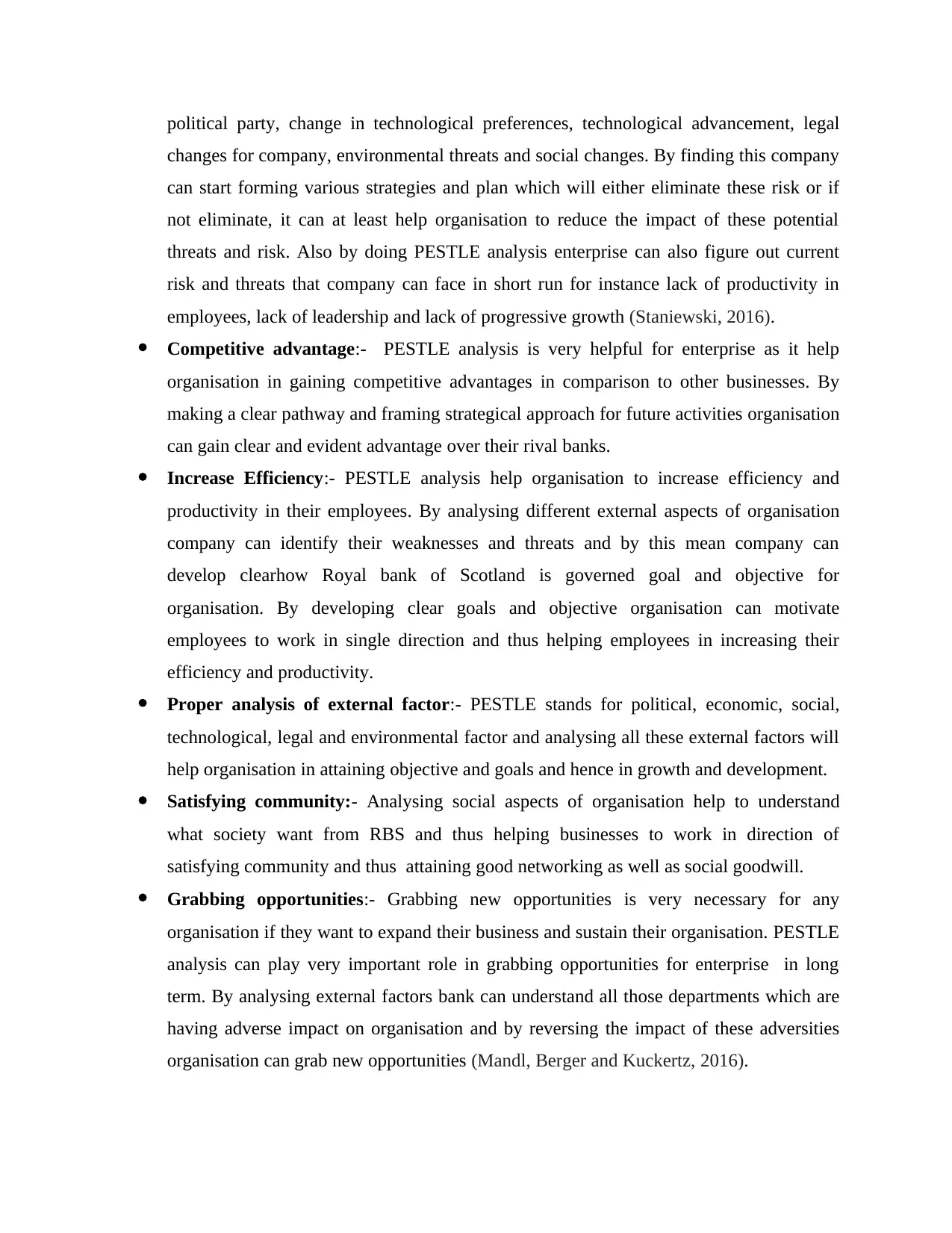
political party, change in technological preferences, technological advancement, legal
changes for company, environmental threats and social changes. By finding this company
can start forming various strategies and plan which will either eliminate these risk or if
not eliminate, it can at least help organisation to reduce the impact of these potential
threats and risk. Also by doing PESTLE analysis enterprise can also figure out current
risk and threats that company can face in short run for instance lack of productivity in
employees, lack of leadership and lack of progressive growth (Staniewski, 2016).
Competitive advantage:- PESTLE analysis is very helpful for enterprise as it help
organisation in gaining competitive advantages in comparison to other businesses. By
making a clear pathway and framing strategical approach for future activities organisation
can gain clear and evident advantage over their rival banks.
Increase Efficiency:- PESTLE analysis help organisation to increase efficiency and
productivity in their employees. By analysing different external aspects of organisation
company can identify their weaknesses and threats and by this mean company can
develop clearhow Royal bank of Scotland is governed goal and objective for
organisation. By developing clear goals and objective organisation can motivate
employees to work in single direction and thus helping employees in increasing their
efficiency and productivity.
Proper analysis of external factor:- PESTLE stands for political, economic, social,
technological, legal and environmental factor and analysing all these external factors will
help organisation in attaining objective and goals and hence in growth and development.
Satisfying community:- Analysing social aspects of organisation help to understand
what society want from RBS and thus helping businesses to work in direction of
satisfying community and thus attaining good networking as well as social goodwill.
Grabbing opportunities:- Grabbing new opportunities is very necessary for any
organisation if they want to expand their business and sustain their organisation. PESTLE
analysis can play very important role in grabbing opportunities for enterprise in long
term. By analysing external factors bank can understand all those departments which are
having adverse impact on organisation and by reversing the impact of these adversities
organisation can grab new opportunities (Mandl, Berger and Kuckertz, 2016).
changes for company, environmental threats and social changes. By finding this company
can start forming various strategies and plan which will either eliminate these risk or if
not eliminate, it can at least help organisation to reduce the impact of these potential
threats and risk. Also by doing PESTLE analysis enterprise can also figure out current
risk and threats that company can face in short run for instance lack of productivity in
employees, lack of leadership and lack of progressive growth (Staniewski, 2016).
Competitive advantage:- PESTLE analysis is very helpful for enterprise as it help
organisation in gaining competitive advantages in comparison to other businesses. By
making a clear pathway and framing strategical approach for future activities organisation
can gain clear and evident advantage over their rival banks.
Increase Efficiency:- PESTLE analysis help organisation to increase efficiency and
productivity in their employees. By analysing different external aspects of organisation
company can identify their weaknesses and threats and by this mean company can
develop clearhow Royal bank of Scotland is governed goal and objective for
organisation. By developing clear goals and objective organisation can motivate
employees to work in single direction and thus helping employees in increasing their
efficiency and productivity.
Proper analysis of external factor:- PESTLE stands for political, economic, social,
technological, legal and environmental factor and analysing all these external factors will
help organisation in attaining objective and goals and hence in growth and development.
Satisfying community:- Analysing social aspects of organisation help to understand
what society want from RBS and thus helping businesses to work in direction of
satisfying community and thus attaining good networking as well as social goodwill.
Grabbing opportunities:- Grabbing new opportunities is very necessary for any
organisation if they want to expand their business and sustain their organisation. PESTLE
analysis can play very important role in grabbing opportunities for enterprise in long
term. By analysing external factors bank can understand all those departments which are
having adverse impact on organisation and by reversing the impact of these adversities
organisation can grab new opportunities (Mandl, Berger and Kuckertz, 2016).
⊘ This is a preview!⊘
Do you want full access?
Subscribe today to unlock all pages.

Trusted by 1+ million students worldwide
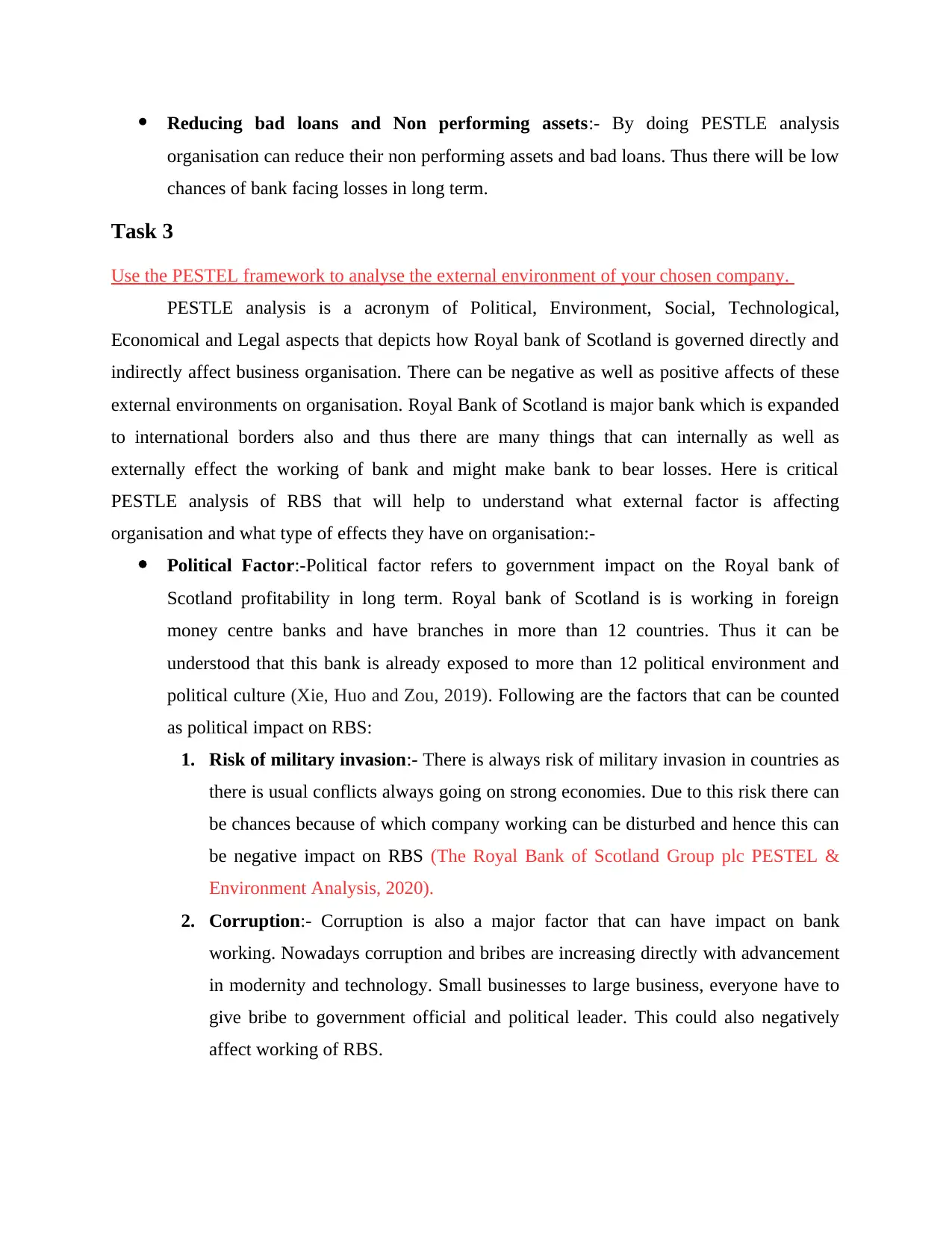
Reducing bad loans and Non performing assets:- By doing PESTLE analysis
organisation can reduce their non performing assets and bad loans. Thus there will be low
chances of bank facing losses in long term.
Task 3
Use the PESTEL framework to analyse the external environment of your chosen company.
PESTLE analysis is a acronym of Political, Environment, Social, Technological,
Economical and Legal aspects that depicts how Royal bank of Scotland is governed directly and
indirectly affect business organisation. There can be negative as well as positive affects of these
external environments on organisation. Royal Bank of Scotland is major bank which is expanded
to international borders also and thus there are many things that can internally as well as
externally effect the working of bank and might make bank to bear losses. Here is critical
PESTLE analysis of RBS that will help to understand what external factor is affecting
organisation and what type of effects they have on organisation:-
Political Factor:-Political factor refers to government impact on the Royal bank of
Scotland profitability in long term. Royal bank of Scotland is is working in foreign
money centre banks and have branches in more than 12 countries. Thus it can be
understood that this bank is already exposed to more than 12 political environment and
political culture (Xie, Huo and Zou, 2019). Following are the factors that can be counted
as political impact on RBS:
1. Risk of military invasion:- There is always risk of military invasion in countries as
there is usual conflicts always going on strong economies. Due to this risk there can
be chances because of which company working can be disturbed and hence this can
be negative impact on RBS (The Royal Bank of Scotland Group plc PESTEL &
Environment Analysis, 2020).
2. Corruption:- Corruption is also a major factor that can have impact on bank
working. Nowadays corruption and bribes are increasing directly with advancement
in modernity and technology. Small businesses to large business, everyone have to
give bribe to government official and political leader. This could also negatively
affect working of RBS.
organisation can reduce their non performing assets and bad loans. Thus there will be low
chances of bank facing losses in long term.
Task 3
Use the PESTEL framework to analyse the external environment of your chosen company.
PESTLE analysis is a acronym of Political, Environment, Social, Technological,
Economical and Legal aspects that depicts how Royal bank of Scotland is governed directly and
indirectly affect business organisation. There can be negative as well as positive affects of these
external environments on organisation. Royal Bank of Scotland is major bank which is expanded
to international borders also and thus there are many things that can internally as well as
externally effect the working of bank and might make bank to bear losses. Here is critical
PESTLE analysis of RBS that will help to understand what external factor is affecting
organisation and what type of effects they have on organisation:-
Political Factor:-Political factor refers to government impact on the Royal bank of
Scotland profitability in long term. Royal bank of Scotland is is working in foreign
money centre banks and have branches in more than 12 countries. Thus it can be
understood that this bank is already exposed to more than 12 political environment and
political culture (Xie, Huo and Zou, 2019). Following are the factors that can be counted
as political impact on RBS:
1. Risk of military invasion:- There is always risk of military invasion in countries as
there is usual conflicts always going on strong economies. Due to this risk there can
be chances because of which company working can be disturbed and hence this can
be negative impact on RBS (The Royal Bank of Scotland Group plc PESTEL &
Environment Analysis, 2020).
2. Corruption:- Corruption is also a major factor that can have impact on bank
working. Nowadays corruption and bribes are increasing directly with advancement
in modernity and technology. Small businesses to large business, everyone have to
give bribe to government official and political leader. This could also negatively
affect working of RBS.
Paraphrase This Document
Need a fresh take? Get an instant paraphrase of this document with our AI Paraphraser
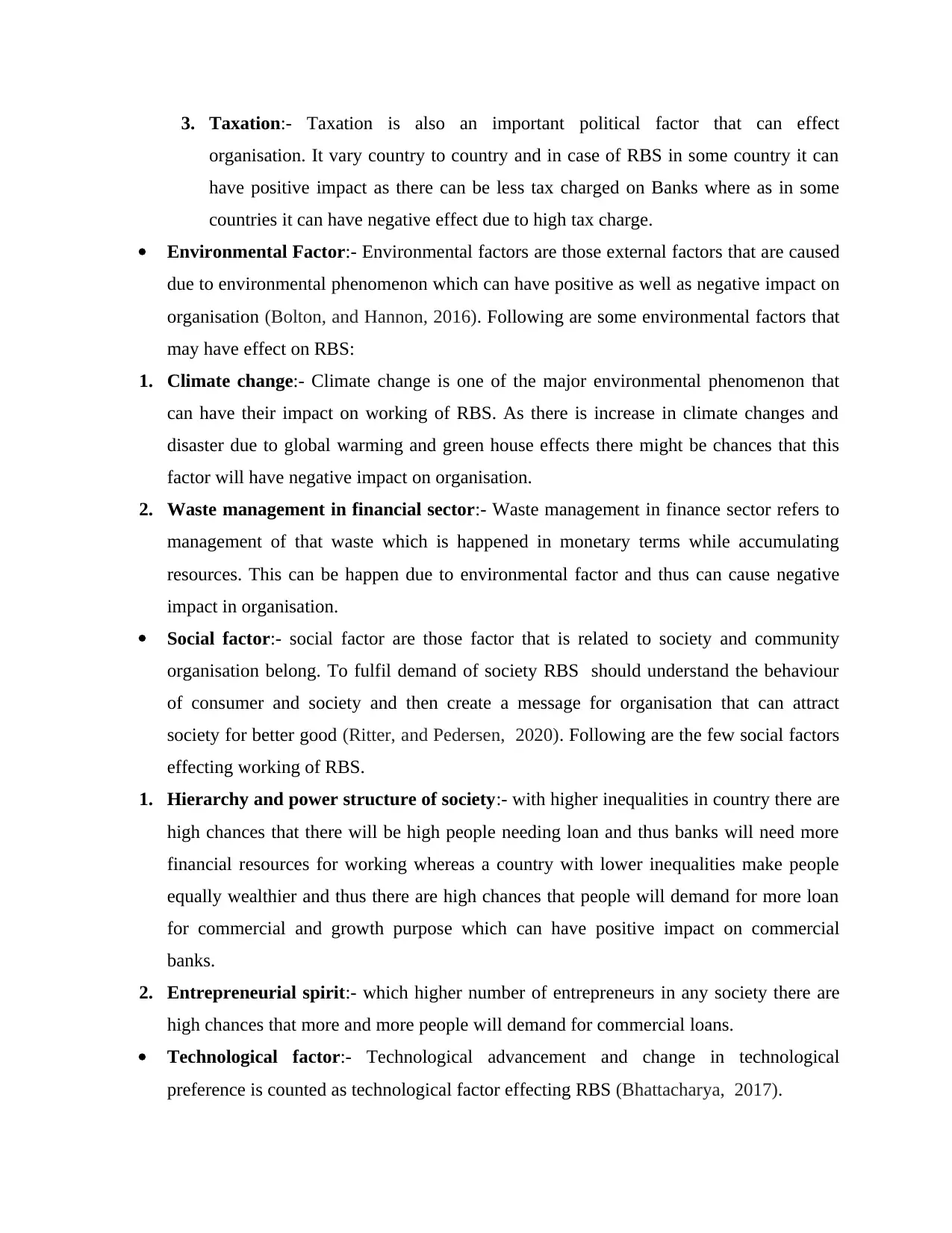
3. Taxation:- Taxation is also an important political factor that can effect
organisation. It vary country to country and in case of RBS in some country it can
have positive impact as there can be less tax charged on Banks where as in some
countries it can have negative effect due to high tax charge.
Environmental Factor:- Environmental factors are those external factors that are caused
due to environmental phenomenon which can have positive as well as negative impact on
organisation (Bolton, and Hannon, 2016). Following are some environmental factors that
may have effect on RBS:
1. Climate change:- Climate change is one of the major environmental phenomenon that
can have their impact on working of RBS. As there is increase in climate changes and
disaster due to global warming and green house effects there might be chances that this
factor will have negative impact on organisation.
2. Waste management in financial sector:- Waste management in finance sector refers to
management of that waste which is happened in monetary terms while accumulating
resources. This can be happen due to environmental factor and thus can cause negative
impact in organisation.
Social factor:- social factor are those factor that is related to society and community
organisation belong. To fulfil demand of society RBS should understand the behaviour
of consumer and society and then create a message for organisation that can attract
society for better good (Ritter, and Pedersen, 2020). Following are the few social factors
effecting working of RBS.
1. Hierarchy and power structure of society:- with higher inequalities in country there are
high chances that there will be high people needing loan and thus banks will need more
financial resources for working whereas a country with lower inequalities make people
equally wealthier and thus there are high chances that people will demand for more loan
for commercial and growth purpose which can have positive impact on commercial
banks.
2. Entrepreneurial spirit:- which higher number of entrepreneurs in any society there are
high chances that more and more people will demand for commercial loans.
Technological factor:- Technological advancement and change in technological
preference is counted as technological factor effecting RBS (Bhattacharya, 2017).
organisation. It vary country to country and in case of RBS in some country it can
have positive impact as there can be less tax charged on Banks where as in some
countries it can have negative effect due to high tax charge.
Environmental Factor:- Environmental factors are those external factors that are caused
due to environmental phenomenon which can have positive as well as negative impact on
organisation (Bolton, and Hannon, 2016). Following are some environmental factors that
may have effect on RBS:
1. Climate change:- Climate change is one of the major environmental phenomenon that
can have their impact on working of RBS. As there is increase in climate changes and
disaster due to global warming and green house effects there might be chances that this
factor will have negative impact on organisation.
2. Waste management in financial sector:- Waste management in finance sector refers to
management of that waste which is happened in monetary terms while accumulating
resources. This can be happen due to environmental factor and thus can cause negative
impact in organisation.
Social factor:- social factor are those factor that is related to society and community
organisation belong. To fulfil demand of society RBS should understand the behaviour
of consumer and society and then create a message for organisation that can attract
society for better good (Ritter, and Pedersen, 2020). Following are the few social factors
effecting working of RBS.
1. Hierarchy and power structure of society:- with higher inequalities in country there are
high chances that there will be high people needing loan and thus banks will need more
financial resources for working whereas a country with lower inequalities make people
equally wealthier and thus there are high chances that people will demand for more loan
for commercial and growth purpose which can have positive impact on commercial
banks.
2. Entrepreneurial spirit:- which higher number of entrepreneurs in any society there are
high chances that more and more people will demand for commercial loans.
Technological factor:- Technological advancement and change in technological
preference is counted as technological factor effecting RBS (Bhattacharya, 2017).
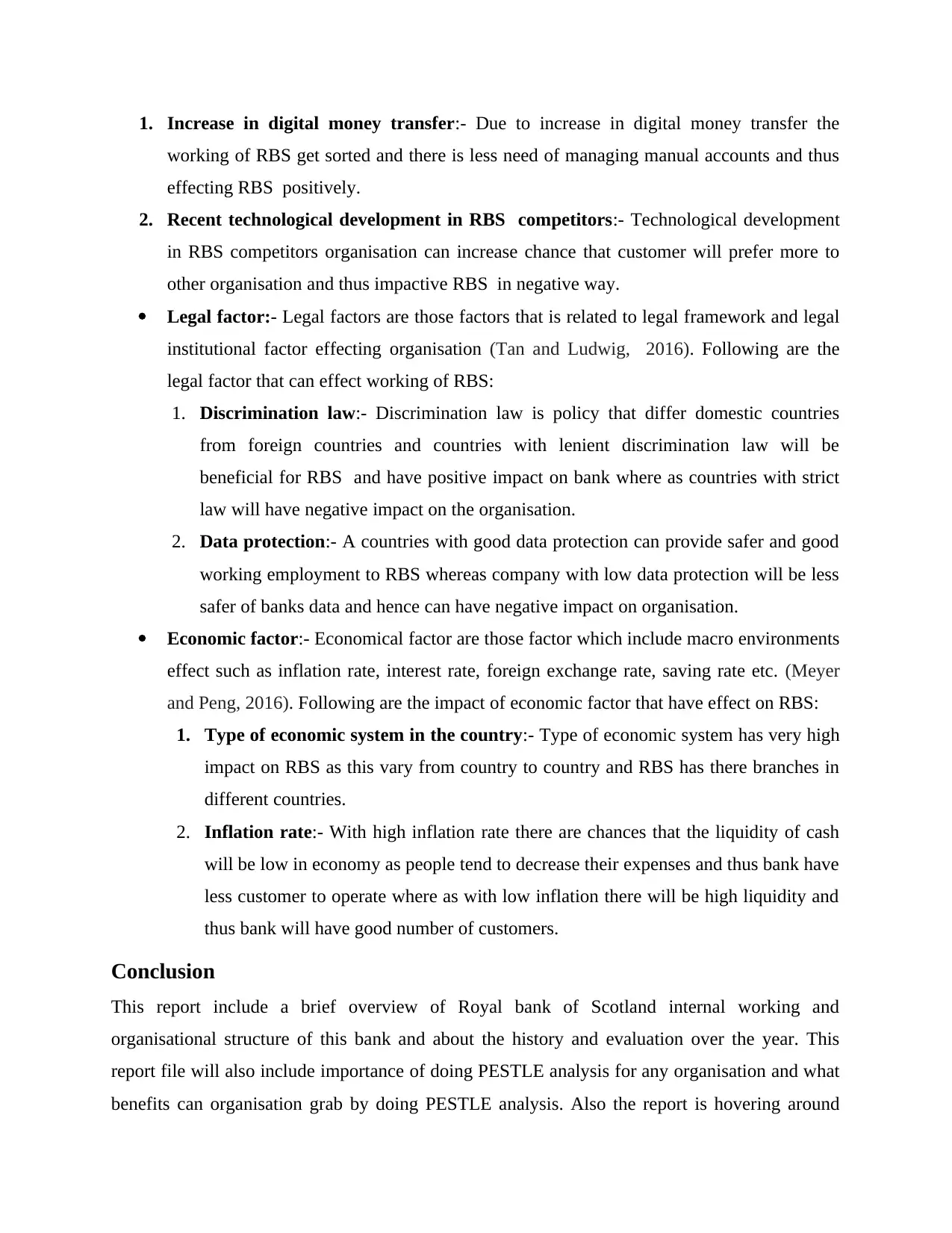
1. Increase in digital money transfer:- Due to increase in digital money transfer the
working of RBS get sorted and there is less need of managing manual accounts and thus
effecting RBS positively.
2. Recent technological development in RBS competitors:- Technological development
in RBS competitors organisation can increase chance that customer will prefer more to
other organisation and thus impactive RBS in negative way.
Legal factor:- Legal factors are those factors that is related to legal framework and legal
institutional factor effecting organisation (Tan and Ludwig, 2016). Following are the
legal factor that can effect working of RBS:
1. Discrimination law:- Discrimination law is policy that differ domestic countries
from foreign countries and countries with lenient discrimination law will be
beneficial for RBS and have positive impact on bank where as countries with strict
law will have negative impact on the organisation.
2. Data protection:- A countries with good data protection can provide safer and good
working employment to RBS whereas company with low data protection will be less
safer of banks data and hence can have negative impact on organisation.
Economic factor:- Economical factor are those factor which include macro environments
effect such as inflation rate, interest rate, foreign exchange rate, saving rate etc. (Meyer
and Peng, 2016). Following are the impact of economic factor that have effect on RBS:
1. Type of economic system in the country:- Type of economic system has very high
impact on RBS as this vary from country to country and RBS has there branches in
different countries.
2. Inflation rate:- With high inflation rate there are chances that the liquidity of cash
will be low in economy as people tend to decrease their expenses and thus bank have
less customer to operate where as with low inflation there will be high liquidity and
thus bank will have good number of customers.
Conclusion
This report include a brief overview of Royal bank of Scotland internal working and
organisational structure of this bank and about the history and evaluation over the year. This
report file will also include importance of doing PESTLE analysis for any organisation and what
benefits can organisation grab by doing PESTLE analysis. Also the report is hovering around
working of RBS get sorted and there is less need of managing manual accounts and thus
effecting RBS positively.
2. Recent technological development in RBS competitors:- Technological development
in RBS competitors organisation can increase chance that customer will prefer more to
other organisation and thus impactive RBS in negative way.
Legal factor:- Legal factors are those factors that is related to legal framework and legal
institutional factor effecting organisation (Tan and Ludwig, 2016). Following are the
legal factor that can effect working of RBS:
1. Discrimination law:- Discrimination law is policy that differ domestic countries
from foreign countries and countries with lenient discrimination law will be
beneficial for RBS and have positive impact on bank where as countries with strict
law will have negative impact on the organisation.
2. Data protection:- A countries with good data protection can provide safer and good
working employment to RBS whereas company with low data protection will be less
safer of banks data and hence can have negative impact on organisation.
Economic factor:- Economical factor are those factor which include macro environments
effect such as inflation rate, interest rate, foreign exchange rate, saving rate etc. (Meyer
and Peng, 2016). Following are the impact of economic factor that have effect on RBS:
1. Type of economic system in the country:- Type of economic system has very high
impact on RBS as this vary from country to country and RBS has there branches in
different countries.
2. Inflation rate:- With high inflation rate there are chances that the liquidity of cash
will be low in economy as people tend to decrease their expenses and thus bank have
less customer to operate where as with low inflation there will be high liquidity and
thus bank will have good number of customers.
Conclusion
This report include a brief overview of Royal bank of Scotland internal working and
organisational structure of this bank and about the history and evaluation over the year. This
report file will also include importance of doing PESTLE analysis for any organisation and what
benefits can organisation grab by doing PESTLE analysis. Also the report is hovering around
⊘ This is a preview!⊘
Do you want full access?
Subscribe today to unlock all pages.

Trusted by 1+ million students worldwide
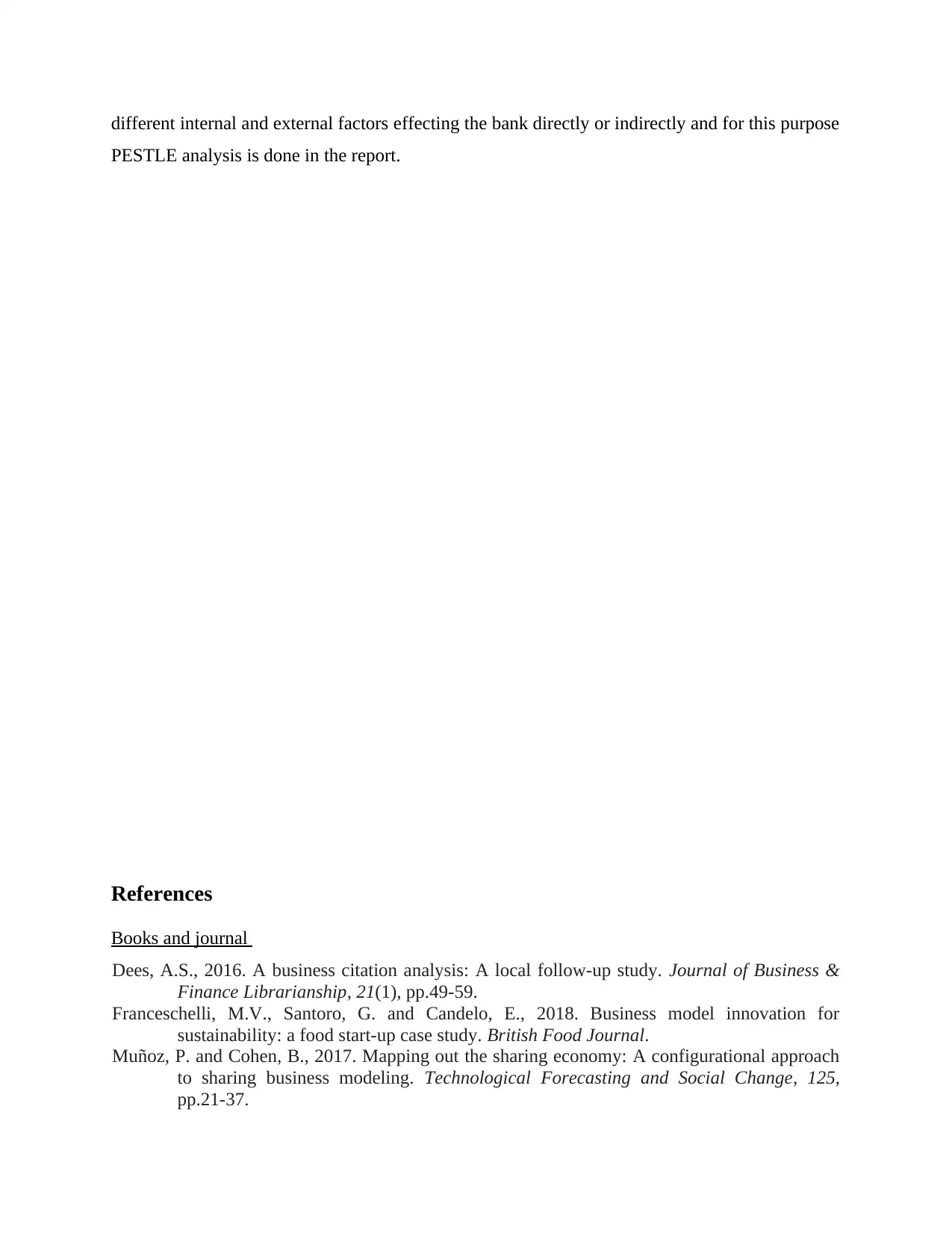
different internal and external factors effecting the bank directly or indirectly and for this purpose
PESTLE analysis is done in the report.
References
Books and journal
Dees, A.S., 2016. A business citation analysis: A local follow-up study. Journal of Business &
Finance Librarianship, 21(1), pp.49-59.
Franceschelli, M.V., Santoro, G. and Candelo, E., 2018. Business model innovation for
sustainability: a food start-up case study. British Food Journal.
Muñoz, P. and Cohen, B., 2017. Mapping out the sharing economy: A configurational approach
to sharing business modeling. Technological Forecasting and Social Change, 125,
pp.21-37.
PESTLE analysis is done in the report.
References
Books and journal
Dees, A.S., 2016. A business citation analysis: A local follow-up study. Journal of Business &
Finance Librarianship, 21(1), pp.49-59.
Franceschelli, M.V., Santoro, G. and Candelo, E., 2018. Business model innovation for
sustainability: a food start-up case study. British Food Journal.
Muñoz, P. and Cohen, B., 2017. Mapping out the sharing economy: A configurational approach
to sharing business modeling. Technological Forecasting and Social Change, 125,
pp.21-37.
Paraphrase This Document
Need a fresh take? Get an instant paraphrase of this document with our AI Paraphraser
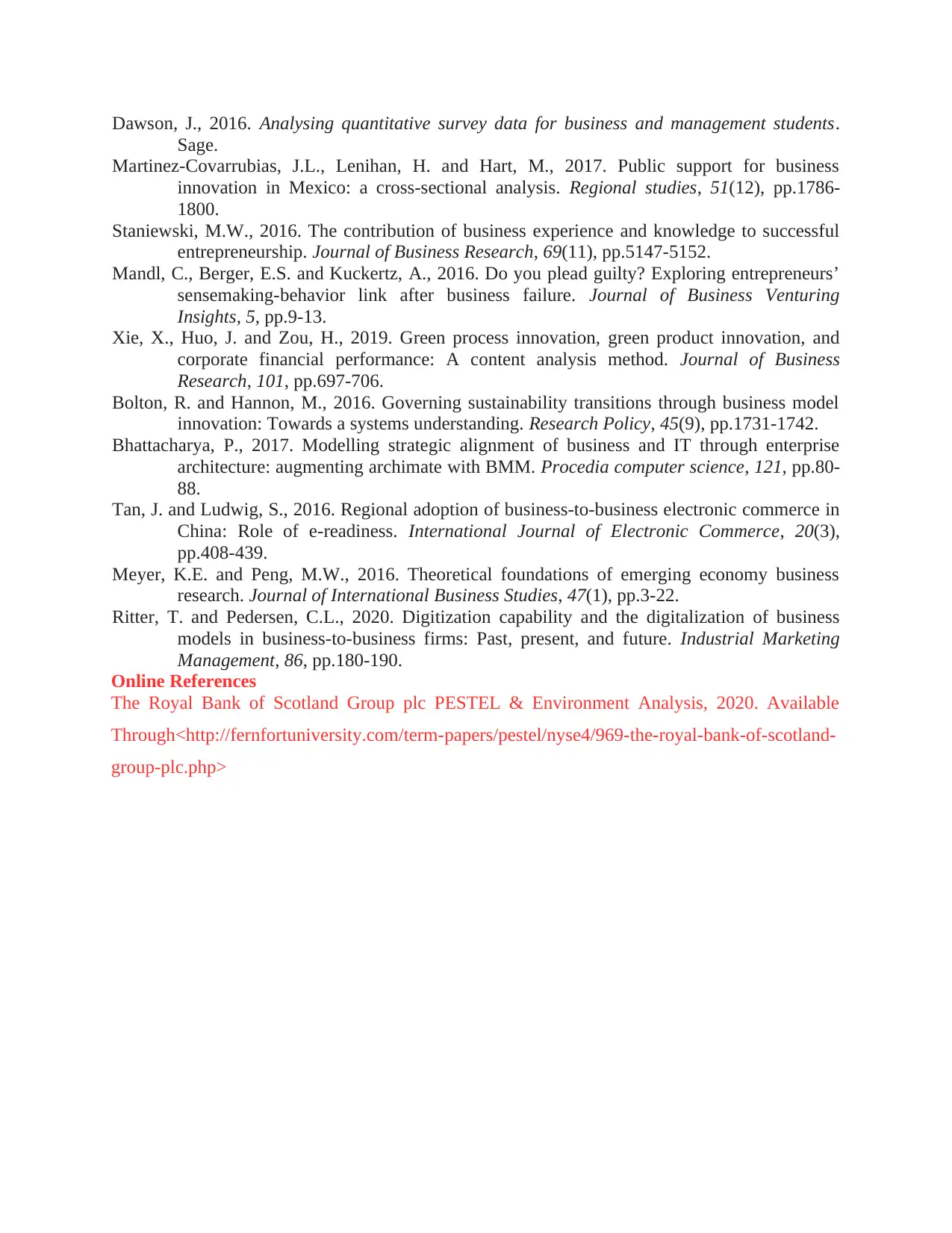
Dawson, J., 2016. Analysing quantitative survey data for business and management students.
Sage.
Martinez-Covarrubias, J.L., Lenihan, H. and Hart, M., 2017. Public support for business
innovation in Mexico: a cross-sectional analysis. Regional studies, 51(12), pp.1786-
1800.
Staniewski, M.W., 2016. The contribution of business experience and knowledge to successful
entrepreneurship. Journal of Business Research, 69(11), pp.5147-5152.
Mandl, C., Berger, E.S. and Kuckertz, A., 2016. Do you plead guilty? Exploring entrepreneurs’
sensemaking-behavior link after business failure. Journal of Business Venturing
Insights, 5, pp.9-13.
Xie, X., Huo, J. and Zou, H., 2019. Green process innovation, green product innovation, and
corporate financial performance: A content analysis method. Journal of Business
Research, 101, pp.697-706.
Bolton, R. and Hannon, M., 2016. Governing sustainability transitions through business model
innovation: Towards a systems understanding. Research Policy, 45(9), pp.1731-1742.
Bhattacharya, P., 2017. Modelling strategic alignment of business and IT through enterprise
architecture: augmenting archimate with BMM. Procedia computer science, 121, pp.80-
88.
Tan, J. and Ludwig, S., 2016. Regional adoption of business-to-business electronic commerce in
China: Role of e-readiness. International Journal of Electronic Commerce, 20(3),
pp.408-439.
Meyer, K.E. and Peng, M.W., 2016. Theoretical foundations of emerging economy business
research. Journal of International Business Studies, 47(1), pp.3-22.
Ritter, T. and Pedersen, C.L., 2020. Digitization capability and the digitalization of business
models in business-to-business firms: Past, present, and future. Industrial Marketing
Management, 86, pp.180-190.
Online References
The Royal Bank of Scotland Group plc PESTEL & Environment Analysis, 2020. Available
Through<http://fernfortuniversity.com/term-papers/pestel/nyse4/969-the-royal-bank-of-scotland-
group-plc.php>
Sage.
Martinez-Covarrubias, J.L., Lenihan, H. and Hart, M., 2017. Public support for business
innovation in Mexico: a cross-sectional analysis. Regional studies, 51(12), pp.1786-
1800.
Staniewski, M.W., 2016. The contribution of business experience and knowledge to successful
entrepreneurship. Journal of Business Research, 69(11), pp.5147-5152.
Mandl, C., Berger, E.S. and Kuckertz, A., 2016. Do you plead guilty? Exploring entrepreneurs’
sensemaking-behavior link after business failure. Journal of Business Venturing
Insights, 5, pp.9-13.
Xie, X., Huo, J. and Zou, H., 2019. Green process innovation, green product innovation, and
corporate financial performance: A content analysis method. Journal of Business
Research, 101, pp.697-706.
Bolton, R. and Hannon, M., 2016. Governing sustainability transitions through business model
innovation: Towards a systems understanding. Research Policy, 45(9), pp.1731-1742.
Bhattacharya, P., 2017. Modelling strategic alignment of business and IT through enterprise
architecture: augmenting archimate with BMM. Procedia computer science, 121, pp.80-
88.
Tan, J. and Ludwig, S., 2016. Regional adoption of business-to-business electronic commerce in
China: Role of e-readiness. International Journal of Electronic Commerce, 20(3),
pp.408-439.
Meyer, K.E. and Peng, M.W., 2016. Theoretical foundations of emerging economy business
research. Journal of International Business Studies, 47(1), pp.3-22.
Ritter, T. and Pedersen, C.L., 2020. Digitization capability and the digitalization of business
models in business-to-business firms: Past, present, and future. Industrial Marketing
Management, 86, pp.180-190.
Online References
The Royal Bank of Scotland Group plc PESTEL & Environment Analysis, 2020. Available
Through<http://fernfortuniversity.com/term-papers/pestel/nyse4/969-the-royal-bank-of-scotland-
group-plc.php>
1 out of 11
Related Documents
Your All-in-One AI-Powered Toolkit for Academic Success.
+13062052269
info@desklib.com
Available 24*7 on WhatsApp / Email
![[object Object]](/_next/static/media/star-bottom.7253800d.svg)
Unlock your academic potential
Copyright © 2020–2025 A2Z Services. All Rights Reserved. Developed and managed by ZUCOL.





